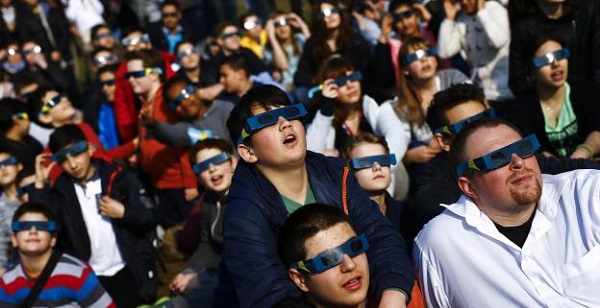The European Union prepared with great seriousness for the impact of Friday’s solar eclipse on electricity supply and demand with predictions that it could knock out most grids in its member nations.
During the eclipse, the moon blocked about 80% of the sun’s light across Europe from about 8 a.m. to 11 a.m. London time on Friday March 20th, 2015.
This phenomenon, though as mesmerizing to the population and to astrophysicists around the world–it was a nightmare for the European Network of Transmission System Operators and for solar enthusiasts like myself. It was also a fit for Germany as this event briefly switched off and then on again thousands of solar photovoltaic panels that on the brightest days fuel 40% of the entire country’s power.
 Computer monitors indicate the forecasted power loss at the 50 Hertz Transmission Control Center in Neuenhagen, Germany. The transmission provider is preparing to compensate the expected power loss during the partial solar eclipse. Image Credit: Bernd Settnik/dpa/Corbis
Computer monitors indicate the forecasted power loss at the 50 Hertz Transmission Control Center in Neuenhagen, Germany. The transmission provider is preparing to compensate the expected power loss during the partial solar eclipse. Image Credit: Bernd Settnik/dpa/Corbis
As we all may know, ‘dips’ in alternative energy production has tremendously negative effects on any electric grid. This was specifically an unprecedented test for the European grid.
Fortunately enough, European citizens and businesses can rely on a secure supply of electricity.
In fact, this solar eclipse had the potential to cause all sorts of mayhem, but turned out to be an engineering challenge akin to the one that utilities deal with every day. Despite the 2.5-hour solar eclipse and the steep ramp-down and ramp-up of solar power that it caused, electrical grids on the continent managed to deal with the disruption.
— GreenTechMedia
The fast variations in solar generation and the difficult-to-anticipate impact on demand were successfully managed by Transmission System Operators (TSOs) thanks to meticulous preparation, and strong regional and European cooperation.
Europe saw a decrease in solar power of a total 17GW and an increase afterwards by 25GW, said Pierre Bornard, deputy chief executive of French grid RTE and chairman of grid company lobby ENTSO-E.
— Reuters
“Europeans are used to just push a button to switch the light on. They tend to forget all the highly technical and complex systems and tasks needed to maintain a constant balance between generation and demand on an interconnected Power System” says Pierre Bornard, Deputy CEO of the French TSO RTE and Chairman of the Board of the European Network for Transmission System Operators, ENTSO-E.
The TSOs had managed to forecast with a lot of precision the effect of the eclipse on solar generation; taking even into account the ‘worst case scenario’ that the eclipse would take place on a sunny day.
“The solar eclipse is an example for the success of European and regional cooperation organised by ENTSO-E”, says Konstantin Staschus, Secretary-General of ENTSO-E.
“Many other aspects of European electricity market integration are solved in the network codes delivered by ENTSO-E to regulators and the European Commission. It is urgent, that we see a swift adoption of the network codes. So, with the network codes in place, when the next solar eclipse takes place in 2026, the management of such challenging event will be much easier”, continues Konstantin Staschus.











Comments